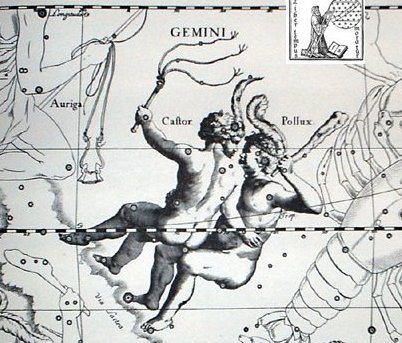In G the last glyph in line a1 is the first of 12 Rei glyphs (all on side a). The first 3 of them form a group:
Rei in Ka2-10 (see below) is in parallel with Ga1-30, but the stars are those which in G are positioned at the glyph after its Rei. Because below I have allowed K to follow the pace of the G text in spite of there being no parallel to the pair Ga1-20--21. There simply is no room on the small K tablet to present this pair of glyphs in line a1. The creator of the K text may have thought the 2nd and 3rd stars in the Belt of Orion, Alnilam and Alnitak, already were represented, so to say, at the beginning of the text (as I have argumented for in my comments on line Ka1):
The Heavenly Gate star (ζ Tauri) is a name which suggests the opening through which 'sky persons' enters into view. They were not only Sun, because Alnilam (ε Orionis) can be read as a 'String of Pearls', which seems to be confirmed by the Chinese picture of this region:
On the other hand I have added the day corresponding to Ka2-6:
I now find the order better in K than in G. It ought to be the magnificent Canopus who with his toki creates the new fire, and this should be done in a black region (which agrees with the date - 25 - in the Gregorian calendar). The first of the Charioteer's whip stars is ψ1 and it is pleasing to see it coordinated with the toki sign, because both are powerful activating instruments. Rei in Ka2-10 is at the ruling star of the Chinese moon station Well:
In the K text St John's Day is coordinated with the Rei glyph and in G with tagata toki. After the first 40 days in the Arabic manzil structure the new station Al Tuwaibe', ruled by Aldebaran, indicates the beginning of the nawaa with the same name. A major division of time comes with day 177 (= 6 * 29½) counted from January 1. Tejat Posterior is μ Gemini, rising 2 days after Tejat Prior (η), and this 'gate' is on the other side of the Milky Way River compared to Orion:
The left foot of Castor, with η at the heel, is still in the River, but his right foot (with μ) is on 'dry land'. | ||||||||||||||||||||||||||||||||||||||||||||||||||||||||||||||||||||||||||||||||||||||||||||||||||||||||||||









